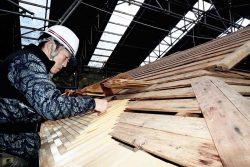
A whale-shaped festival float is seen in Akishima, Tokyo, on Aug. 4, 2019.
15:15 JST, February 16, 2021
With whales featured on manhole covers and street lamps, the aquatic mammals serve as the symbol of Akishima, a city in western Tokyo. In August every year, the city even holds a local whale festival.
However, Akishima is nowhere near the sea.
Why, then, do its residents love whales so much?
To find out, I walked around the city, spying whale images everywhere I went.

One of the street lamps depicting the silhouette of a whale
Cubic street lamps measuring 30 centimeters on a side line a 450-meter stretch of Tsutsujigaoka-dori street, which goes past a community center. The lights of the street lamps illuminate silhouettes of whales spouting water.
There is a whale on the cover of a manhole on a sidewalk in front of the city government building. In front of JR Higashi-Nakagami Station, there is a sign depicting a smiling whale.
Locals call the shopping center in front of the station Kujira Road (Whale road). Along the Tama River, children play sports at Kujira Undo Koen (Whale athletic park). The nickname of the city’s education and welfare center is Akishimaenshisu, which is named after the scientific name of a whale species.
Turning the whale into the city’s symbol began when an almost complete skeleton of an ancient whale was unearthed within the riverbanks of Tama River in the city.
In August 1961, Masato Tajima, a science teacher of the city’s municipal Tamagawa Elementary School, went to the riverbank to play with his 4-year-old son. He found what looked like animal bones buried there in a 10-meter-long section of the riverbank.
A university professor and researchers examined the bones and found they were the fossils of a dozen-meter-long whale that lived millions of years ago. The set of fossils drew great interest from the locals, who dubbed the animal the Akishima whale.
“I heard a fossil craze hit the city right after the discovery,” said Tajima’s son Yoshio, now 64.
But the craze was short-lived. As there were few whale researchers in those days, the fossils were put in separate boxes and languished in storage in Shinjuku Ward, Tokyo, at an annex of the National Museum of Nature and Science.
That changed in 2012. The museum’s annex was to be relocated, and the city government needed to find a location to store the fossils. Then, the Gunma Museum of Natural History was chosen to keep the fossils. The Gunma museum boasted a young and talented whale researcher, Toshiyuki Kimura, 50.
Kimura and his fellow researchers visited museums all over the world and had compared the fossils from Akishima with other fossils. Based on the shapes of the whale bones’ nose, jaws and forehead, they concluded the Akishima whale was a newly discovered species.

A manhole cover on which appears an image of a whale.
In January 2018, the researchers posted in an English journal of the Palaeontological Society of Japan that the Akishima whale was indeed a new species. The scientific name of the Akishima whale, Eschrichtius akishaimaensis, was officially reported to researchers throughout the world.
Recognition of the discovery in the scientific field took a while, but residents of the city rediscovered the value of the whale fossils only about 10 years after their riverbank discovery.
Until then, the city of Akishima lacked a proper symbol, and the whale was hoped to be a boost to the city.
In 1973, the city held its first summer festival for residents, and it featured a float in the shape of an about 15-meter-long whale. From 1984, the names of two festivals were changed to the Kujira Matsuri and Shimin Kujira Matsuri, both meaning whale festivals.
“I don’t know any other fossils so loved and used for promotion by a local community,” Kimura said.
The year 2021 marks the 60th anniversary of the discovery of the fossils. The city government plans to hold an event in which all parts of the fossils will be put together in the city and displayed to the public, possibly in the summer.
To begin this process, fossils of the Akishima whale’s ribs and blade bone, among others, were brought back to the city on Dec. 23.
“Only a few people in this city have seen the entirety of the whale’s skeletal framework,” said Masahiko Ito, a section chief of the city’s board of education who planned the project. “By seeing it whole, people may feel an even deeper affinity for it.”

The skeleton of the Akishima whale is reconstructed in 1962.
Related Tags
"Features" POPULAR ARTICLE
-

Students Recreate 19th-Century Bento Boxes Made for Ino Tadataka’s Survey Team in Hot Spring Town on Nakasendo Road
-

Santa Claus Delivers Christmas Presents to Penguins at Aquarium in Japan’s Nagasaki Prefecture
-

Sumo Restaurant in Tokyo Teaches Foreign Visitors About the Ancient Sport, with Bouts Between Retired Rikishi
-

Autonomous Passenger Ship Connects Mainland with Remote Island in Seto Inland Sea; World’s 1st Commercially Operated Autonomous Vessel
-

Osaka’s Sumiyoshi Taisha Shrine Bustles with New Year’s Visitors
JN ACCESS RANKING
-

As Chinese Tourists Shun Japan, Hotels and Stores Suffer
-

Osaka-Kansai Expo’s Economic Impact Estimated at ¥3.6 Trillion, Takes Actual Visitor Numbers into Account
-

Japan Govt Adopts Measures to Curb Mega Solar Power Plant Projects Amid Environmental Concerns
-

BOJ Gov. Ueda: Highly Likely Mechanism for Rising Wages, Prices Will Be Maintained
-

Economic Security Panels Debate Supply Chains, Rare Earths; Participants Emphasize Importance of Cooperation Among Allies

























